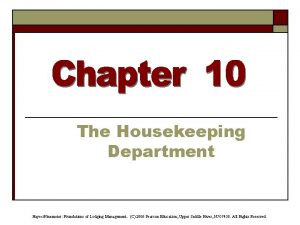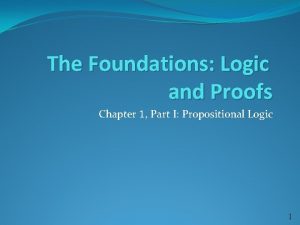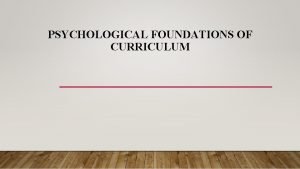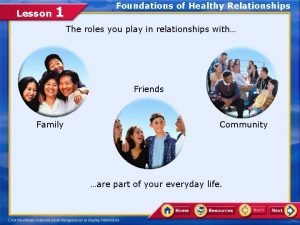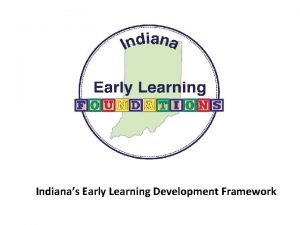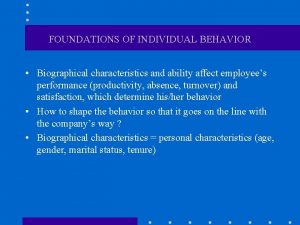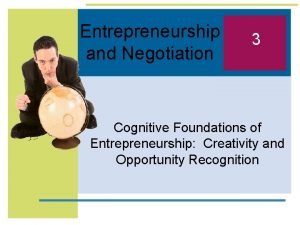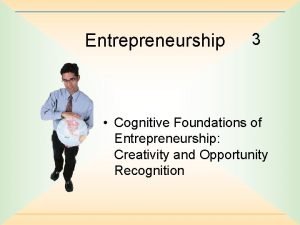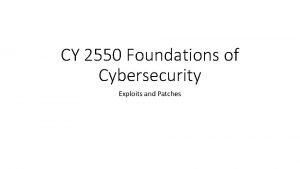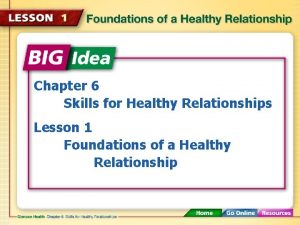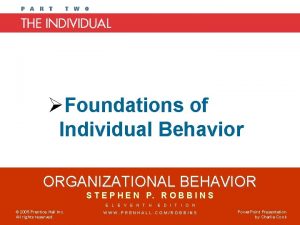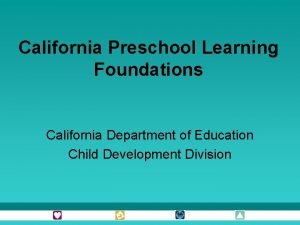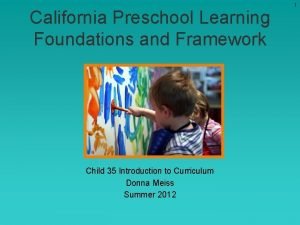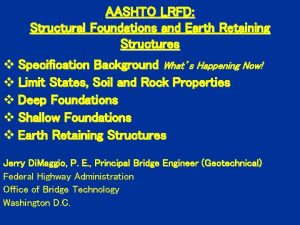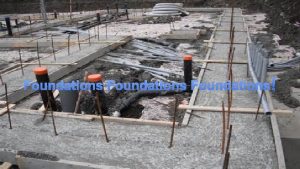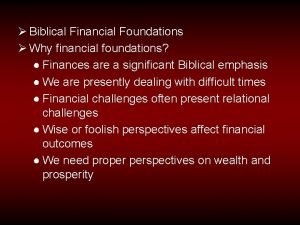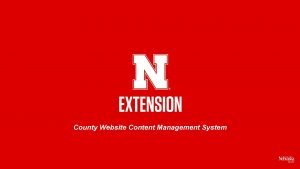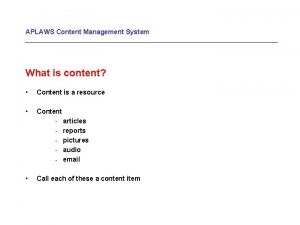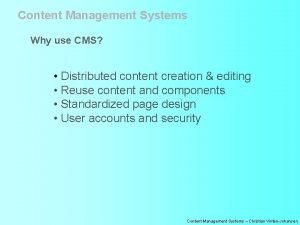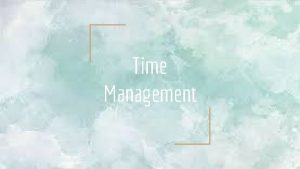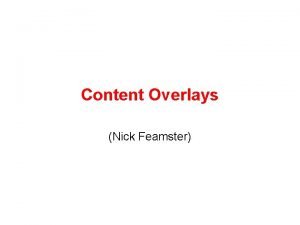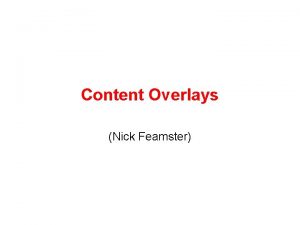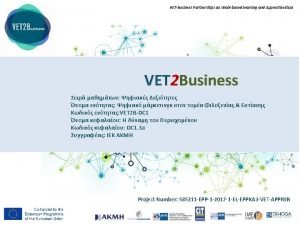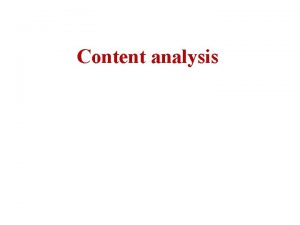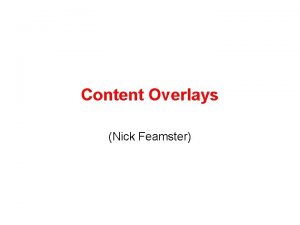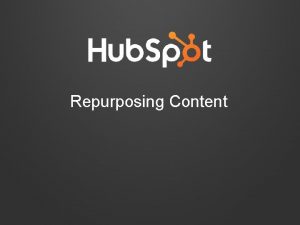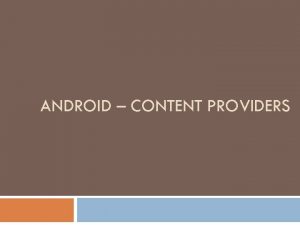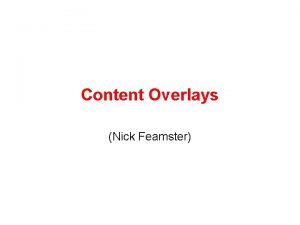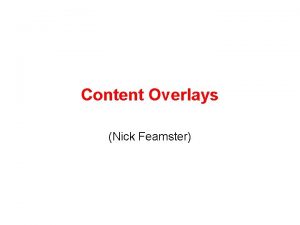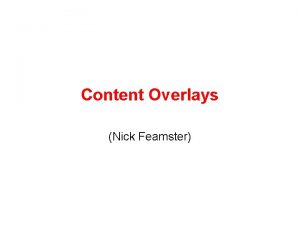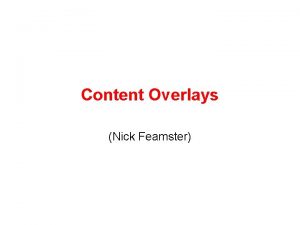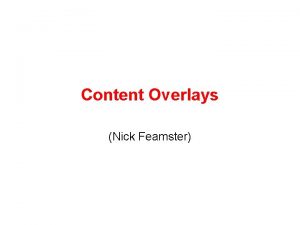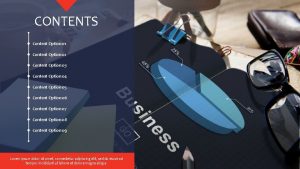Content management I Foundations of content management Why



























- Slides: 27

Content management I. Foundations of content management • Why we have to manage content • What is CMS? II. How do CMS work? • Technical infrastructure III. Content management during site design • Responsibilities • Sourcing content • Asset management Advanced Information Architecture- Fall 02

I. Foundations of content management II. • Why we have to manage content III. Web sites are growing way too quickly IV. Outdated content is typically placed in archives V. Tools to create new content are becoming easier to use VI. This increases the pool of potential authors VII. There are economic and organizational pressures to move more information to the web Inside every small web site is a huge web site struggling to get out Suh et al. (2002) Content Management Systems. New Riders. http: //www. webreference. com/authoring/languages/html/cmsystems/ chap 1/ Advanced Information Architecture- Fall 02

How many authors do you have? How many items does each author create or change per month? Ex: news, press releases, short tidbits, calendar events, articles 3 authors @ 5 items a month: 15 updates a month; 180 per year 5 authors @ 10 items a month: 50 updates a month; 600 per year 100 authors @ 12 items a month: 1200 updates a month; 14, 400 per year If the number of authors increases and they post the same amount of content, the number of updates increases Advanced Information Architecture- Fall 02

Factors that drive CMS The number of pages on commercial, academic, and government sites continues to increase Users are becoming more demanding and sophisticated People in the organization want changes, updates, and revisions This causes bottlenecks on page production Slowdowns can lead to stale content and inconsistency An unintended consequence of the slowdown is that it’s easier for them to absolve themselves of responsibility for the site Technology changes the way an organization creates and manages content Advanced Information Architecture- Fall 02

Old-school content management Many web sites were originally done by hand Hand coding does not scale for large and complex web sites There was an inter-dependency between design, code, and content People on the team would typically do several tasks Changing one part meant changing everything There was no clear production process This was not really necessary with small teams and small sites Issue: what parts of the process can be automated? Advanced Information Architecture- Fall 02

The advantage of CMS Content management applies technology to automate the most tedious parts of the old school approach It defines a system for separating site design from the server code The server code is kept separate from the content A CMS provides the means and the opportunity to make a site manageable It will change the workflow of the web team It should result in cost and time savings over time Advanced Information Architecture- Fall 02

What is a Content Management System (CMS) ? It refers to products that offer the basic technical infrastructure for developing, organizing and publishing content Three main tools: Asset management interface Used to create and manage content Repository Used to store content Template engine Used to publish content Advanced Information Architecture- Fall 02

What do CMS do? CMS automate the process of creating, publishing, and updating Web site content They make maintaining and updating the content of a site easier Content contributors have ability to manage their own content CMS usually have three components A front-end editor for inputting content A back-end system for storing the content A template mechanism to get the content onto the site Advanced Information Architecture- Fall 02

Content management involves publishing content with digital tools In its simplest form, it does three things: Asset management Creating, organizing, and managing units of content Preparing content for publishing and dissemination Transformation Presenting the content Deciding on formats and layouts Publishing Delivering the content to the audience Determining the channels for delivery Advanced Information Architecture- Fall 02

CMS involve workflow management, linking work practices and the CMS infrastructure It is a predefined series of tasks through which content is created and published It describes the progression of content through the asset management, transformation, and publishing activities It makes work processes explicit and systematic It applies rules to users and tasks to manage a process A good workflow tool automates reminders to move content assets through the entire process It generates logs so that we understand what is going on, what the status of each content item is, and where the bottlenecks exist Advanced Information Architecture- Fall 02

CMS is a sociotechnical system composed of the people involved (authors, editors, and developers) and the technology that supports them Content management is a group activity, and requires cooperation to succeed It involves coordination and collaboration Business processes involved in the production of the web site have to be examined It is important to understand what people do in the production process Putting in place a technology infrastructure that will support that collaboration is not a trivial activity Advanced Information Architecture- Fall 02

It also includes the broader social and organizational context in which these tools are used This always involves the business environment of the organization The goals, culture, and decision-making processes must be taken into account It typically centers on the purposes of the web site Organizations and people use web sites to communicate CMS supports the technical aspects of digital communication It is intended to help people get their jobs done faster and more efficiently Advanced Information Architecture- Fall 02

Planning and implementing CMS is a serious high-level strategic activity Selecting a CMS is typically a job for CTOs or IT department heads because of the high cost of the tools It is important for the IA to have input into this process CMS affects many people in an organization It will change their workflows and there will be a learning curve It will lead to policy changes There is work to be done to convince the stakeholders that such a system is necessary These systems are new enough that the impacts on organizations is often not widely understood Advanced Information Architecture- Fall 02

Content management I. Foundations of content management • Why we have to manage content • What is CMS? II. How do CMS work? • Technical infrastructure III. Content management during site design • Responsibilities • Sourcing content • Asset management Advanced Information Architecture- Fall 02

How CMS work Technical Infrastructure Content creation Users add content via a browser-based interface The interface is similar to the web site It typically has rich text editing capabilities Asset management is handled within this interface Users edit existing content, compare versions of content, and to approve content for publication Some systems are integrated with apps such as Office or Dreamweaver Advanced Information Architecture- Fall 02

Some provide custom client-side applications This may be a richer editing environment, or allow administrative tasks An application programming interface (API) allows users to add or manipulate content stored via scripts Workflow helps manage the flow of content through this technical structure It ensures that the IA is aware of and can approve what happens throughout Version control helps people track changes to the content allowing management of change The administrator assigns users and groups to certain roles and actions User access control levels (ACL) Advanced Information Architecture- Fall 02

Repository The repository can be a database, a closed file system, or a mixture of both It can be virtual One interface can provide access to numerous backend data sources It stores content and any associated metadata Metadata enables a range of content management functions Allows the CMS to deliver more precise searches, It can generate topic-based navigation and create links to related pages It can track workflow status Advanced Information Architecture- Fall 02

Publishing A template engine applies design elements to content, in order to produce the desired output document The templates themselves usually contain placeholders for content from the repository More powerful schemes can allow inline code to be interpreted in the templates Link management refers to how the tool tracks and maintains internal links and site navigation This can be driven by an internally maintained glossary of unique content Ids Other systems handle it by referring to a user-created site structure, which is also used to create navigation Advanced Information Architecture- Fall 02

Static publishing Pages are created and uploaded Dynamic publishing Content is uploaded to the database When a request for a web page is received, the template engine publishes the content using the template A dynamic server requires more processing power, but is useful for presenting constantly changing or frequently updated content Tools Webreference. com. (2001). Content Management Tools http: //www. webreference. com/authoring/languages/html/site. html Advanced Information Architecture- Fall 02

Content management I. Foundations of content management • Why we have to manage content • What is CMS? II. How do CMS work? • Technical infrastructure III. Content management during site design • Responsibilities • Sourcing content • Asset management Advanced Information Architecture- Fall 02

III. Content management during site design • Responsibilities This is a major part of the design and production phases of the project The IA develops and oversees the content management process for the project There should be a clear path for content development and delivery Creation --> editing --> formatting --> proofing --> submission --> publishing --> storing --> version control It also involves issues of copyright clearance and payments and possibly syndication contracts There should be procedures for updating and removal of content Advanced Information Architecture- Fall 02

Sourcing content Where will the content cone from? Creation of original content Who will do the work (in-house or outsourced)? If internal, what are the relevant procedures for getting to content to the team? If external, what are the terms of the contract? Content syndication The IA should understand the timetables involved in receiving this type of content It is also important to be familiar with the contract This will specify formats to be delivered, depth of content, frequency of updating, error control… Advanced Information Architecture- Fall 02

Free content Always consider the source and quality of the content Be careful about proper attributions Reusing/repurposing content If the client is supplying content , make sure to inspect it carefully Issue: how much work is involved in getting the content into the proper form for publishing Stock/library content This is content that you have acquired or that you can purchase from a source Be careful about clearances and avoid cliches Keep careful records of source for each item Advanced Information Architecture- Fall 02

Managing content providers This is where IAs rely on the project plan There should be a specification explaining how the various providers (clients and outsourcers) are to deliver content This should lay out formatting requirements, benchmarks, deadlines and payment schedules (where appropriate) It is important for the client to understand the role of content development and delivery in the overall development process Have backup plans to keep the work going in case the content is late Advanced Information Architecture- Fall 02

Managing content formats In general, specify exact formats Only accept content in digital format Text Use an content exchange format that is idiot-proof for clients (. rtf? . pdf? ) If using software (Quark? ) make sure that your team and the content provider are using the same version If the content is to be entered into a database, develop a usable, web-based entry interface Images Start with as high a resolution as you can get Insist on standardized image formats Advanced Information Architecture- Fall 02

Audio Again, get the highest quality file you can Make sure that you have access to the technology you need to process the file formats you will be dealing witt Make clear the distinction between encoding audio for the web and editing audio files Streaming or downloading? Video Similar to audio but even more expensive Be aware of the range of international standards affecting video recording and playback Advanced Information Architecture- Fall 02

Asset tracking and management Have procedures in place to log and track the content that is going into (and out of) the site An easy way is to use a file structure that mirrors the basic site architecture and store content in the appropriate place Use subdirectories labeled by file format For larger sites, use a database to store content Keep a file that is used to check arrival of content and track versions Save the email! Advanced Information Architecture- Fall 02
 Hey hey bye bye
Hey hey bye bye Dont ask why why why
Dont ask why why why The generic term for the guest room sheets and pillowcases
The generic term for the guest room sheets and pillowcases Multinational financial management definition
Multinational financial management definition What is esp
What is esp Dynamic content vs static content
Dynamic content vs static content Idempotent law example
Idempotent law example The foundations logic and proofs
The foundations logic and proofs California preschool curriculum framework volume 1
California preschool curriculum framework volume 1 Behaviorism vs humanism
Behaviorism vs humanism New foundations foster care
New foundations foster care What are the three c's of healthy relationships
What are the three c's of healthy relationships Indiana early learning foundations
Indiana early learning foundations History and geography the foundations of culture
History and geography the foundations of culture Foundations of individual behaviour
Foundations of individual behaviour Foundations of business 5th edition
Foundations of business 5th edition Cognitive foundations of entrepreneurship
Cognitive foundations of entrepreneurship Cognitive foundations of entrepreneurship
Cognitive foundations of entrepreneurship Cy 2550 northeastern
Cy 2550 northeastern Chapter 6 skills for healthy relationships
Chapter 6 skills for healthy relationships Chapter 2 the nursing assistant and the care team
Chapter 2 the nursing assistant and the care team Foundation of individual behaviour
Foundation of individual behaviour California learning foundations
California learning foundations Preschool learning foundations volume 1
Preschool learning foundations volume 1 Aohs foundations of anatomy and physiology 1
Aohs foundations of anatomy and physiology 1 Aohs foundations of anatomy and physiology 2
Aohs foundations of anatomy and physiology 2 Foundations and earth retaining structures
Foundations and earth retaining structures Preschool learning foundations volume 3
Preschool learning foundations volume 3


